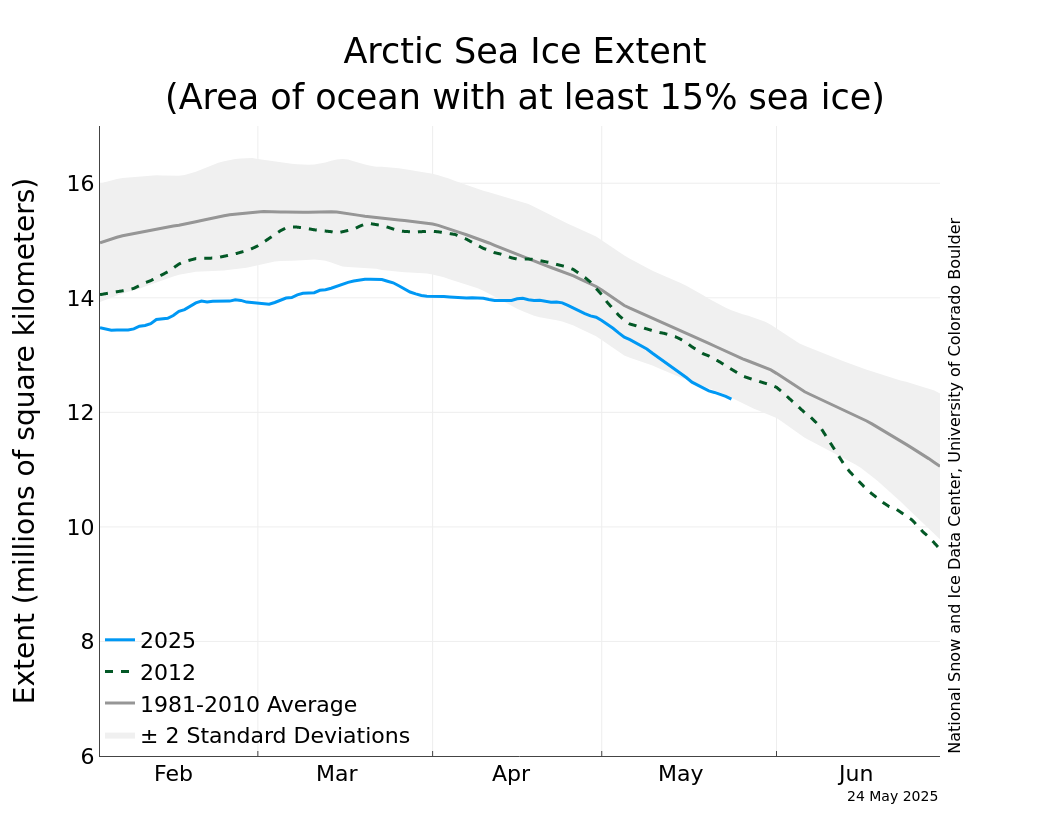Old Rocks
Diamond Member
Strong atmospheric chemistry feedback to climate warming from Arctic methane emissions
Strong atmospheric chemistry feedback to climate warming from Arctic methane emissions
Strong atmospheric chemistry feedback to climate warming from Arctic methane emissions
Key Points
The importance of atmospheric chemistry in response to permafrost emissions
Ivar S. A. Isaksen
Department of Geosciences, University of Oslo, Oslo, Norway
Center for International Climate and Environmental ResearchOslo, Oslo, Norway
Michael Gauss
Department of Geosciences, University of Oslo, Oslo, Norway
Norwegian Meteorological Institute, Oslo, Norway
Gunnar Myhre
Department of Geosciences, University of Oslo, Oslo, Norway
Center for International Climate and Environmental ResearchOslo, Oslo, Norway
Katey M. Walter Anthony
Water and Environmental Research Center, Institute of Northern Engineering and International Arctic Research, University of Alaska, Fairbanks, Alaska, USA
Carolyn Ruppel
U.S. Geological Survey, Woods Hole, Massachusetts, USA
The magnitude and feedbacks of future methane release from the Arctic region are unknown. Despite limited documentation of potential future releases associated with thawing permafrost and degassing methane hydrates, the large potential for future methane releases calls for improved understanding of the interaction of a changing climate with processes in the Arctic and chemical feedbacks in the atmosphere. Here we apply a state of the art atmospheric chemistry transport model to show that large emissions of CH 4 would likely have an unexpectedly large impact on the chemical composition of the atmosphere and on radiative forcing (RF). The indirect contribution to RF of additional methane emission is particularly important. It is shown that if global methane emissions were to increase by factors of 2.5 and 5.2 above current emissions, the indirect contributions to RF would be about 250% and 400%, respectively, of the RF that can be attributed to directly emitted methane alone. Assuming several hypothetical scenarios of CH 4 release associated with permafrost thaw, shallow marine hydrate degassing, and submarine landslides, we find a strong positive feedback on RF through atmospheric chemistry. In particular, the impact of CH 4 is enhanced through increase of its lifetime, and of atmospheric abundances of ozone, stratospheric water vapor, and CO 2 as a result of atmospheric chemical processes. Despite uncertainties in emission scenarios, our results provide a better understanding of the feedbacks in the atmospheric chemistry that would amplify climate warming.
Strong atmospheric chemistry feedback to climate warming from Arctic methane emissions
Strong atmospheric chemistry feedback to climate warming from Arctic methane emissions
Key Points
The importance of atmospheric chemistry in response to permafrost emissions
Ivar S. A. Isaksen
Department of Geosciences, University of Oslo, Oslo, Norway
Center for International Climate and Environmental ResearchOslo, Oslo, Norway
Michael Gauss
Department of Geosciences, University of Oslo, Oslo, Norway
Norwegian Meteorological Institute, Oslo, Norway
Gunnar Myhre
Department of Geosciences, University of Oslo, Oslo, Norway
Center for International Climate and Environmental ResearchOslo, Oslo, Norway
Katey M. Walter Anthony
Water and Environmental Research Center, Institute of Northern Engineering and International Arctic Research, University of Alaska, Fairbanks, Alaska, USA
Carolyn Ruppel
U.S. Geological Survey, Woods Hole, Massachusetts, USA
The magnitude and feedbacks of future methane release from the Arctic region are unknown. Despite limited documentation of potential future releases associated with thawing permafrost and degassing methane hydrates, the large potential for future methane releases calls for improved understanding of the interaction of a changing climate with processes in the Arctic and chemical feedbacks in the atmosphere. Here we apply a state of the art atmospheric chemistry transport model to show that large emissions of CH 4 would likely have an unexpectedly large impact on the chemical composition of the atmosphere and on radiative forcing (RF). The indirect contribution to RF of additional methane emission is particularly important. It is shown that if global methane emissions were to increase by factors of 2.5 and 5.2 above current emissions, the indirect contributions to RF would be about 250% and 400%, respectively, of the RF that can be attributed to directly emitted methane alone. Assuming several hypothetical scenarios of CH 4 release associated with permafrost thaw, shallow marine hydrate degassing, and submarine landslides, we find a strong positive feedback on RF through atmospheric chemistry. In particular, the impact of CH 4 is enhanced through increase of its lifetime, and of atmospheric abundances of ozone, stratospheric water vapor, and CO 2 as a result of atmospheric chemical processes. Despite uncertainties in emission scenarios, our results provide a better understanding of the feedbacks in the atmospheric chemistry that would amplify climate warming.













